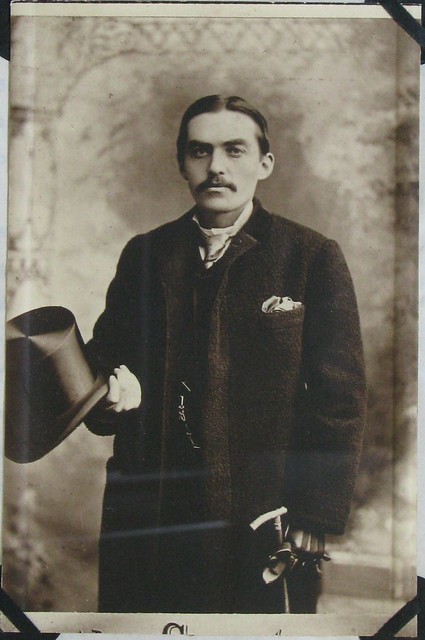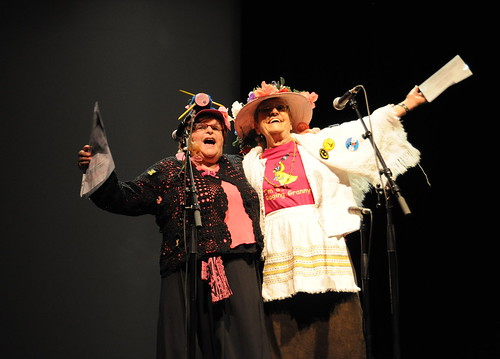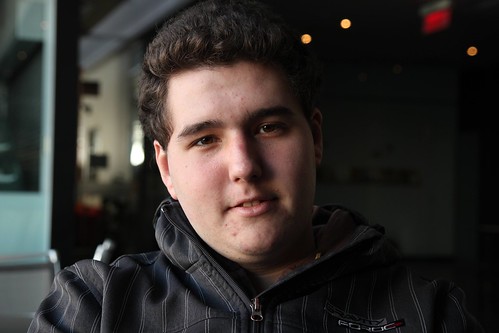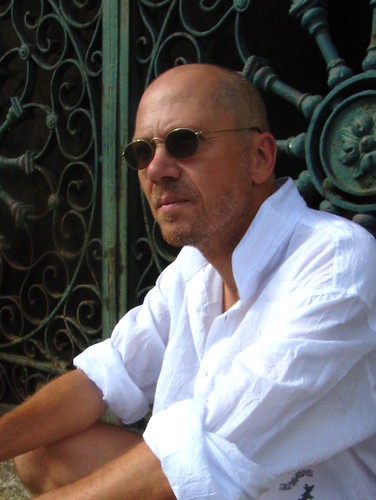Danny Raymond, Alex ‘Breezy’ Bryson, Mikerson ‘Swagga Kid’ Stiverne and his older brother Michael ‘da Prince Stiverne.
Category: My own projects
Blog Changing Its Skin
The other day I went to see spring arrive at the Montapen falls north of Joliette, an hour and a half’s drive from Montreal.
Dear subscribers and other readers,
As you may or may not have noticed, with the overwhelming influx of messages which afflicts most of us, my blog has not been active for about six weeks – except for an old post which went out the other day. The immediate reason for this was a nasty malware-infection which has now been cleaned up thanks to my friends and colleagues Kim Gjerstad and Barry Greenwald and our hosting service Web Hosting Canada. However, it was time for the blog to change anyway. I am facing some serious health challenges, and will not be able to write as frequently as I used to. There was a time when I attempted to cover most significant developments in the world of documentary as well as presenting some of my own work, posting every week. From now on, I will write less frequently, and will focus on issues which are very close to my heart, or on people with whom I have a special relationship.
One of my upcoming posts will deal with La grande invasion, (the great invasion) a film about the devastating impact of real estate development gone wild in the Laurentians north of Montreal. Also coming soon, an interview with my dear friend Ali Kazimi about 3D and documentary – he is an authority on the subject and we have been fine-tuning this interview for several months. And I will have a chance to report on the editing of my own film on the troubled youth of Montreal North.
All the best
MI
Thank you to Sally Rylett for helping with this post.
The Grannies and the Cuban Hat
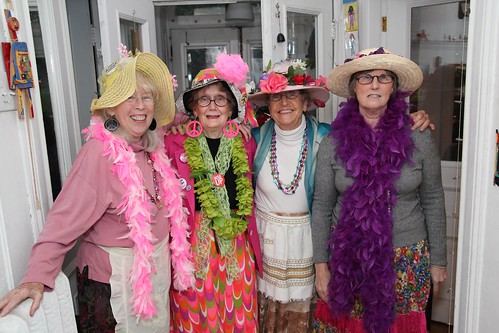
Documentary film funding is not what it used to be. With broadcast windows few and far between and cutbacks everywhere, we doc-makers are turning to other sources, using other methods. And one of the new ways is web-based participatory, or crowd funding. This week I am participating in the Cuban Hat on-line pitch in the framework of the Rencontres Internationales du Documentaire de Montréal.
GRANNY POWER, the project I am pitching (see the video pitch here on Vimeo) together with my colleagues, is a feature length English-language film on the Raging Grannies. This film has been in the works for eight years – and it might as well be crowd funded, because no English-language broadcaster will support it. Could it be that politicized elderly ladies are not the flavour of the month?
The Grannies form a very original protest movement, singing for social justice, peace and environment. They will celebrate their 25th anniversary next summer. The film portrays the movement, but also opens a window on the challenges of remaining active as a citizen as you grow older. Our main characters are between 65 and 80.
Checking out the projects and pitches presented at Cuban Hat is interesting, and the more people vote, the greater the chance that the best projects will become finalists and have a chance to win post production services. Hope you can find the time!
Tobi Elliott, who helps with this blog, is one of the producers of the Granny Film. It was her idea to pitch Granny Power to the Cuban Hat.
Making soup on a nail
For the last two years, I have been working on a film about a man who can be described as a footnote to history, Honoré Joseph Jaxon, alias William Henry Jackson.
An enigmatic figure, his life was full of drama. He admired the Métis and participated in the Northwest Rebellion of 1885, acting as a secretary to Louis Riel. While Riel was hanged for treason, our man was declared insane and let go. He escaped the insane asylum and found himself – less than a year later – involved with the labour movement in Chicago, the fastest-growing industrial city in the U.S.
When anarchist leaders were accused of causing the Haymarket Riot of 1886 – the events which led to the choice of the 1st of May for the annual socialist labour march – he took their defence. Again, his associates were hanged.
Jaxon was an impostor, declaring himself to be a Métis when he was actually born William Henry Jackson of an Ontario methodist family. But he was a visionary, imagining and fighting for a just multicultural society. He ended his days in New York City, where he was evicted from a basement apartment with his huge collection of archives at age 91. He died only a few weeks later.
Jaxon’s story is little known, but Calgary historian Donald Smith has written a terrific book about him, published by Coteau books. Also, Quebec anthropologist and radio host Serge Bouchard did an excellent radio program about him. My own knowledge of Jaxon goes back to the seventies, when I made a series of radio programs about the U.S. labour movement, notably with the help of my friend Pat Quinn, then the Chief archivist at Northwestern University in Evanston/Chicago.
There are of course no moving images of Jaxon, and only a dozen photos. That’s why I say this project is like ‘making soup on a nail,’ recalling an old Scandinavian folk tale about a vagrant who gets himself invited to stay overnight at farm houses by offering to make soup with a nail. ‘If we can just add a little piece of potato, this will be even better….’ You get the idea.
My partners in crime in this undertaking are, among others, scriptwriter Peter Haynes and animator Philippe Vaucher. Here is one of Philippe’s images.
Thanks to Tobi Elliott for her help with the blog.
Projections et télédiffusions, Les Super-Mémés
« …un super film qui donne le goût de vieillir dans la délinquance! » Paul Houde (Montréal Maintenant, 98,5 FM)
Mon film LES SUPER-MÉMÉS, sur les Raging Grannies et les Mémés déchainées, a été lancé en tant de film de clôture du Festival de films sur les droits de la personne en mars 2010. Cet été, il y a plusieurs projections du film en plein air dans le cadre de Cinéma sous les étoiles, et la télédiffusion aura lieu la fin de semaine qui vient.
Cinéma sous les étoiles est une excellente initiative des Productions Funambule, la compagnie de mes jeunes collègues Santiago Bertolino et Steve Patry. Cet été, ils organisent une douzaine de projections dans des parcs dans différents quartiers à Montréal. Parmi les films montrés il y en a plusieurs dont j’ai déjà parlé sur ce blogue, sur Gérald Godin et Omar Khadr notamment.
Il y a quelques semaines, j’ai assisté à une projection des SUPER-MÉMÉS dans le Parc Laurier. Il y avait 80 personnes, et les Mémés étaient sur place pour chanter et discuter après le film.
Le film sera montré dans le cadre d’une autre soirée sous les étoiles, dans le Parc Aimé Léonard à Montréal-Nord le jeudi 1er Septembre à la brunante. J’y serai, ainsi que les Mémés.
Surtout, le film sera diffusé à Canal Vie le 28 Août à 19 heures. C’est en fait grâce à l’investissement de ce diffuseur que nous avons pu faire le film, produit par Les films de l’Isle et distribué par Vidéo-femmes.
Merci a Tobi Elliott pour son aide avec le blogue.
Montréal-Nord – les jeunes
Je vous ai déjà parlé de mon tournage en cours à Montréal-Nord. C’est donc pour un film produit par Jeannine Gagné à Amazone films qui sera diffusé à Canal D. Le processus de ‘casting’ a été long, mais voici mes trois ‘personnages’ principaux, que nous suivons pendant un an et quelques mois.
Danny Raymond est un jeune homme intelligent qui a des talents de ‘leader.’ Il est plein de projets, mais il ne sait pas comment les réaliser. Ayant vécu dans des foyers de groupe et des familles d’accueil pendant une bonne partie de sa jeunesse, il a beaucoup manqué d’encadrement. Il a décroché de l’école avant de finir son secondaire parce qu’il ne se sentait pas accepté et n’étais pas motivé. Il vit encore chez sa mère qui a déjà été contorsionniste au cirque, alors que son père – qu’il voit maintenant quelques fois par année – était clown avant de devenir plombier.
Danny vient d’avoir 18 ans. Il a récemment été accepté pour un projet au Carrefour Jeunesse Emploi. Danny adore la musique et il participe activement à Musique X, un projet communautaire que nous avons suivi depuis ses débuts. Il adore aussi faire de la bicyclette. Les amis sont très importants pour lui, et nous les filmons souvent ensemble.
Michael Stiverne est venu d’Haïti avec son père lorsqu’il avait 10 ans, alors que sa mère est restée là-bas. Le père, chauffeur de taxi au centre-ville, l’a laissé se débrouiller seul et s’occuper de son jeune frère Mickerson. A 22 ans Michael est un jeune homme responsable et motivé, qui a été très apprécié au programme ‘2e Chance’ des Fourchettes de l’Espoir, un organisme communautaire.
Mais il n’a pas toujours été si sage: plus jeune il a été inculpé pour possession d’armes, vols de voitures et trafic de drogue, et il en paye maintenant le prix. Il passe ses fins de semaine en prison, et le restant du temps à se chercher un emploi. Ce qui, pour un jeune noir de Montréal-Nord avec un casier judiciaire n’est pas facile!
Il passe des entrevues de manière assidue, et les employeurs potentiels promettent de le rappeler – mais ne le font presque jamais. Mikerson, 18 ans, a été mis dehors de son école parce qu’il ‘causait du trouble,’ mais comme son frère il est très motivé et essaye de s’en sortir. Il compose de la musique et il chante.
L’absence des parents l’a beaucoup fait souffrir, et il exprime cette douleur de façon touchante. Dans le film nous le verrons notamment raconter l’histoire de sa vie sous forme de rap.
Alexandre Bryson, 17 ans: ‘La violence, la drogue, les coups de feu, j’ai connu ça très jeune, ça ne m’intimide pas,’ dit Alex. Il a grandi à Pointe-aux-Trembles, parfois chez son père, parfois chez sa mère. Ils déménageaient souvent, et au primaire, il a souvent changé d’école. Dès sa jeune enfance, sa mère – d’origine MicMac- est devenue dépendante de la drogue et s’est même prostituée. A l’âge de 12 ans – le jour de son anniversaire – Alex est parti vivre avec son père. Mais lorsque celui-ci est parti travailler en Alberta, Alex s’est retrouvé en foyer d’accueil.
Alex a aimé l’école, et il avait de bons résultats au secondaire, mais l’instabilité de sa vie familiale l’a amené à décrocher après la deuxième année. Il a pris de la drogue, mais l’exemple de son frère ainé qui est accro et qui a fait de la prison l’a convaincu de laisser tomber. La personne qui l’a le plus influencé, en lui disant ‘tu vaux plus que ça’ c’est sa grand-mère paternelle – qu’il aime beaucoup, mais qu’il admet négliger.
Alex est maintenant de retour chez son père, à Bois-des-Filion. Mais il passe souvent du temps à Montréal-Nord. Intelligent et articulé, Alex passe surtout son temps à improviser du rap, ce qu’il fait très bien, seul ou avec des amis. Il a eu 18 ans le 12 juin 2011. Il a été accepté par le programme Katimavik, et ira passer 6 mois à l’Île du prince Edouard et en Ontario à partir de juin.
Merci à Tobi Elliott pour son aide avec le blogue.
Uranium film festival of Brazil

One of my films, Uranium, 1990 (in Canada you can watch it on the NFB website here) was selected to participate in the first international Uranium Film Festival in Brazil, which just ended. (Read a wrapup article here from Environment News Service.)
As Brazil is not known for its uranium or nuclear industry, I found this intriguing. I put some questions to Marcia Gomez de Oliveira, the Director of the Festival, and the director of programming Norbert G. Suchanek.
1. Why a festival of films on uranium?
Marcia Gomes de Oliveira: Because nuclear power plants cannot exist without uranium mining. And that factor is still not known to the general population or society. Also totally unknown to the public here in Brazil and in Latin America are the environmental and social consequences and the negative health effects of uranium mining and other installations of the complex nuclear energy industry. Our film festival wants to change that, wants to “popularize” this important information.
Most of the documentaries and movies about uranium, mining, nuclear energy or the Chernobyl disaster have never been shown in Brazil and were never translated into our language, Portuguese. There is a huge language barrier between the English and Portuguese-speaking world. Our festival is the first step in breaking down that wall. In addition, of course we want to stimulate filmmakers, especially filmmakers from Latin America and from Portuguese-speaking African countries, to produce documentaries and movies on nuclear and radioactive subjects.
And why in Brazil?
Marcia: Because we have nuclear power plants and uranium mines. And, starting with ex-president Lula da Silva, the Brazilian government wants not only to triple the production of Yellow Cake but also in the near future export enriched uranium. That is not all. The government is now constructing a third nuclear power plant, Angra 3, and wants to build up to 40 or 50 new nuclear power plants all over Brazil. Our government wants to transform our country into a globally important nuclear power. The Brazilian people until today have not been aware of this huge nuclear program. And we have to discus it, before it becomes reality, before it is too late.
Why on uranium and not for example hydroelectric dams?
The nuclear or uranium question is as important as the question of hydroelectric dams. The difference is that in Brazil, since the 1980s people already know about the negative effects of the big dams and hydroelectric power plants like Itaipu, Tucurui or Balbina. They are visible. However, the effects of radioactivity, the effects of uranium mining are not yet visible in our society. For that, we are working to spread independent information in form of documentaries about the whole nuclear energy complex and the radioactive risks.
2. For Norbert: You have seen pretty much everything that’s been done on uranium mining and its consequences over the last 30 years (40, right ?)
Norbert: As journalist and activist born in formerly West Germany, I followed the nuclear question for more than 30 years now. In Europe, “uranium mining” was always a forgotten subject because most of the uranium mining happens in other continents. The huge uranium mine of East Germany was also “forgotten” because it was simply a secret behind the Iron Curtain. The huge problems in the uranium mines of Portugal were not questioned outside of Portugal because of the language barrier and because that small country in the edge of Europe was not part of the early European Community. Therefore, for decades uranium mining was not visible to the European public and to most of the people worldwide.
Looking at all of them, what role has documentary played with respect to this issue?
Documentaries have been one of the most important vehicles to bring the uranium case into the public. Like I said, mining was not visible for the people, because it happened in secrecy or in other countries. Until today, the question of Nuclear Energy has been mainly fixed on the question of “Nuclear Waste” from nuclear power plants and nuclear accidents.
Starting with documentaries about uranium mining in Australia, documentaries about the fight of indigenous peoples against mines, people in the industrialized nations are becoming slowly aware that the fuel of Nuclear Power plants do not come from heaven. But will require many more documentaries to inform all of our societies, so that the people and their politicians can make correct and wise decisions in future.
Can you mention a couple of films which stand out ?
First of all your documentary Uranium and this is not because I want to be polite. Your documentary is simply a good piece of work with impressive images and one of the first that explores the consequences of uranium mining in Canada in a profound way.
From the other films that we selected for our festival, I personally like very much the documentary Fight for Country (the story of the Jabiluka Blockade) from Pip Starr, a film director who sadly died far too young. In the year 1998, Pip Starr spent over a year working with the aboriginal Mirrar people opposing a second uranium mine on their land. Finally, thousands of people from all over Australia traveled to the Kakadu National Park to join the Mirrar in their struggle. Produced in 2001, Fight for Country shows that people who stand up against uranium mining are not alone!
The third documentary I want to mention is a new production by film director Klara Sager from Sweden. The location of “Under the surface – Om bergen faller sönder“ produced in 2010/11 is the Hotagen, a mountain area in the North of Sweden.
Young, well-educated geo-engineers and technicians are hiking through a beautiful landscape in search for uranium, without any feeling, about what will happen to that amazing place of earth if one day uranium mining starts. On the other side, you have normal local people, elderly, who do not want uranium mining nor uranium prospecting happen in their land.
It is interesting to see, that Swedish people who are against uranium mining are not young students or “hippy”-type activists, but normal, elderly people. Under the surface also brings to light another kind of modern generation conflict – technicians and engineers fresh from the university working for international mining companies against elderly local people, grocery shopkeepers, housewives and the indigenous Sami, reindeer herders, with a totally different concept of nature and living.
Thanks to Tobi Elliott for her help with the blog.
Shooting in Montreal North

For the last nine months – and with six months to go – I have been shooting a documentary in Montreal North. With my DOP Martin Duckworth and our assistant Franck Le Coroller, I have been immersed in the daily reality of a mutli-ethnic ‘underprivileged’ neighborhood.
Compared to downtown Montreal where we live ourselves, this is quite another world, although the differences are not always what you’d expect. The neighborhood has been the subject of much sensationalist press coverage focusing on violence and street gangs, and definitely doesn’t have a good reputation. The ‘Villanueva affair’ which saw a youth killed by police in a park three years ago called attention to the racial profiling and discriminatory attitudes of the police.
Since then, there has been a push for change in Montreal-North. But are things changing fast enough?
At the centre of most of the controversies are the young men of Montreal-North who are considered ‘at risk.’ And they are the subjects of our film. Produced by Jeannine Gagné at Amazone films with a license from Canal D and investment by SODEC and The Canadian Media Fund, it will follow three young men who are struggling to improve their situation despite tremendous difficulties.
Until now, our main challenge has been the ‘casting,’ the choice of our main characters. Each one of the young men we focus on will likely have a link to a community organization that is trying to make a difference in the neighbourhood. In a few weeks I’ll tell you more about them, and about a video training course we organized for one group of young people.

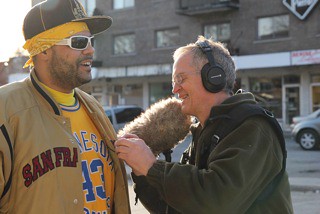
Thanks to Tobi Elliott for help with this blog.
Tournage à Montréal-Nord

Depuis neuf mois – et pour encore six mois – je tourne un documentaire à Montréal-Nord avec le directeur photo Martin Duckworth et notre assistant Franck Le Coroller. Nous sommes plongés dans la réalité quotidienne d’un quartier multi-ethnique défavorisé – un autre monde par rapport au Centre-Ville de Montréal où nous habitons.
Le quartier a fait l’objet d’une couverture médiatique sensationnaliste centrée sur les gangs de rue et la violence et n’a donc pas bonne réputation. ‘L’affaire Villanueva’ qui a vu un policier abattre un jeune homme dans un parc il y a trois ans, a mis en lumière le ‘profilage racial’ et les attitudes discriminatoires de la police. Depuis cette crise, il y a beaucoup d’efforts de changement à Montréal-Nord. Mais les choses changent-elles assez vite?
Au cœur des controverses, il y a la réalité des jeunes hommes ‘à risque’ de Montréal-Nord et c’est là le sujet de notre film. Produit par Jeannine Gagné à Amazone Films avec une license de Canal D et la participation financière de la SODEC et du Fonds des Médias du Canada, il suivra trois jeunes qui font des efforts pour améliorer leur situation malgré le contexte difficile.
Jusqu’à maintenant, notre principal défi a été le ‘casting’: le choix des principaux personnages. Chacun des jeunes que nous choisirons est en lien avec un organisme communautaire qui tente d’aider la jeunesse, et surtout avec des individus clés de ces organismes, travailleurs de rue ou intervenants sociaux.
Dans quelques semaines, je vous présenterai nos principaux personnages. Je vous parlerai aussi d’une formation sur la production vidéo que nous avons donné à quelques jeunes du quartier.


Thanks to Tobi Elliott for help with this blog.
Labour’s New Frontier

Quebec has a higher percentage of union members (about 40%) than Canada as a whole (about 30%) or the United States (about 15%.) Perhaps this is why this province regularly sees pioneering efforts to extend unionization into new sectors. The most recent is the effort to sign up the workers at the Couche-Tard chain’s many convenience stores by the CSN, La confédération des syndicats nationaux.
The majority of employees in several locations have voted for the union. After threatening to close the stores where the workers voted for the union – in a video shown to the employees – management last week did just that, in one important store in Montreal. A choice location, at the corner of St. Denis and Beaubien, not one where the company can argue they were losing money. The union naturally accuses management of intimidation, and is maintaining the pressure.
This battle is reminiscent of one which touched Walmart in Quebec over the last couple of years, and saw that corporation close one major outlet in Jonquière.
This is all quite déjà vu for me, because I followed the attempts to unionize two McDonald’s franchises in Quebec for five years, from 1998 to 2003. I made two films, both produced by Virage and broadcast by Télé-Québec. The first one, Un Syndicat avec ça? (A Union with that?) saw a close-knit gang of experienced workers in Brossard bring in the union.
The second case was quite different. In Maxime, McDuff & McDo I followed two young men who signed up a majority of their very young co-workers in a downtown Montreal franchise on Peel street.
The result? The multinational closed down both restaurants, and there is still no unionized McDonald’s in Canada or the U.S.
The right to free association is a democratic right. How many stores is Couche-Tard willing to close before they accept the union?
Thanks to Tobi Elliott for her help with this blog.


